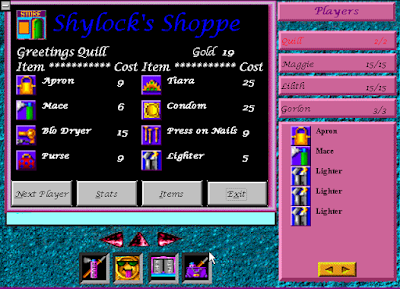From The CRPG Addict
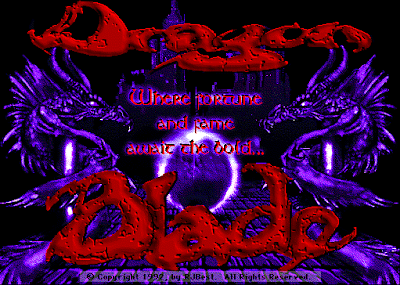 |
| Where fortune and fame await the oold? What does that mean? |
To judge by the manual and character creation process (the only part of the game I could really experience), DragonBlade, offers essentially nothing that Wizardry (1981) doesn’t except for color graphics. But even worse is the re-skinned GayBlade, which bills itself as the first gay-and-lesbian-themed CRPG, which it probably was, but only in the most superficial way. If I were a gay CRPG Addict, neither game would satisfy my gayness nor my CRPG addiction. That GayBlade received so much press in its day goes to show how starved the genre really ways for authentic gay representation in games.
Let’s talk about DragonBlade first. The manual offers the most generic backstory possible: Once peace reigned in the land, led by a community of knights and mages who followed “the gentle philosophy of DragonMagic.” They were headquartered in the DragonKeep and ruled by High Wizard Alastor. But a demon army led by Lord Xygor invaded the land, lay waste to the keep, and imprisoned Alastor in a “dimension of frozen souls.” A party must brave the now-monster-ridden keep to rescue Alastor.
The game opens on a menu town with a “training yard” (character creation), tavern, general store, guild (for level advancement), magic shop, healer, and dungeon door. Classes are fighter, mage, priest, samurai (fighter/priest), wizard (fighter/mage), and master (fighter/priest/wizard). Races are orc (c. 10%), ogre (10%), elf (40%), gnome (20%), and dwarf (20%). When you roll a new character, his race is randomized along with his attributes: strength, wisdom, intelligence, constitution, dexterity, and hits. Each attribute is rolled from 1 to 15 (there are no racial modifications), and the aggregate determines your available classes. So far, with the exception of the monster races and no human race, things are identical to Wizardry
 |
| Except for low hits (which prevents him from being a “master”), this character has some unusually high stats. |
The manual doesn’t tell you the prime requisites for each class, so I spent far more time than made sense noting the minimum scores every time an option came up and then figuring out the associated probabilities. First, there isn’t an equal probability of each number between 1 and 15 appearing for each attribute. For some reason, 8 is heavily weighted, accounting for about 15% of values. The numbers 1 and 15 are weighted low, accounting for about 3% each. Everything else is in the 6-8% range. Priests require at least a 12 in wisdom and mages require at least a 12 in intelligence; each comes up as an option about 21% of the time. Samurai require 13 strength, 12 dexterity, and possibly smaller values for the other attributes. They come up only about 5 times in 1,000. Wizards require at least a 12 in wisdom and dexterity and a 13 in intelligence; they come up 6 times in 1,000. Masters have at least a minimum requirement of 12 or 13 in all attributes (I’m guessing a bit) and come up less than 1 time in every 10,000 rolls. I only ever got one once, and I forgot to click the “Master” option when selecting him, so I accidentally made him a fighter. That hurt.
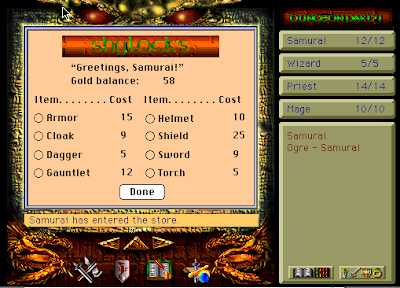 |
| Starting items in the store. |
It turns out that much like Wizardry, it doesn’t make a lot of sense to sweat through thousands of re-rolls for the perfect character anyway, since Level 1 characters might as well be wearing red Star Trek uniforms. This is particularly true for DragonBlade, where enemies attack the moment you enter the dungeon, before you can even light a torch, and never stop. Combat is also Wizardry standard. Each character can attack, parry, use an item, or cast a spell, although it executes the action immediately (more like Might and Magic) rather than running through the entire round at once.
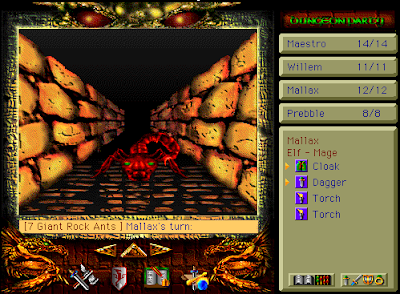 |
| Combat against giant rock ants. |
The game uses Wizardry‘s “slot” system (e.g., a Level 6 priest gets 3 first-level spells, 2 second-level spells, one third-level spell), but there are only 11 spells for each spellcasting class. Mages get “Light Wound,” “Evade,” “Light,” “Heavy Wound,” “Invisibility On,” “Invisibility Off,” “Locate,” “Lightning,” “Fireballs,” “Ice Storm,” and “Castle” (as in, “return to”). Priests get “Disarm” (the only way to disarm, since there are no thieves), “Light Cure,” “Compass,” “Cure Poison,” “Resist Fire,” “Resist Ice,” “Raise,” “Heavy Cure,” “Eye of Death,” “Cure All,” and “Restore.”
 |
| Looking at spell options while facing an undead. |
It soon become clear to me that the programmers had built DragonBlade to serve up a combat once every n clock cycles and hadn’t accounted for faster models. (If I don’t have that quite right technically, I’m sure someone will correct me.) Thus, the combats never end and you never get to explore the dungeon or even retreat out the back door. I tried Citadel of the Dead and ran into essentially the same problem. I could actually get a torch lit and occasionally move a step, but generally speaking I was trapped in an endless succession of combats from the moment I entered until they finally overwhelmed the party. Death is permanent in the game, although one weird feature is that enemies continue to attack slain party members in combat, slashing and bashing their helpless corpses. I guess that’s good news for the survivors but still somewhat gruesome.
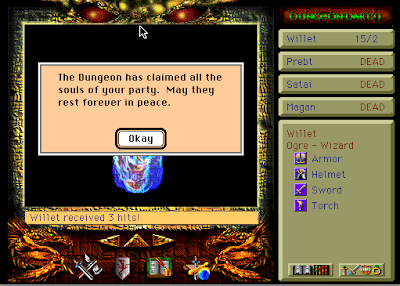 |
| An inevitable message in my DragonBlade experiences. |
The Basilisk emulator that I use for Mac games doesn’t offer dynamic clock speed scaling the way that DOSBox does, and I was unable to find a Windows version of DragonBlade even though it existed. (I think Citadel was Mac-only.) I fiddled around with other models and settings in the Basilisk GUI, but I couldn’t find anything that wasn’t too fast. Thus, I tried GayBlade, for which I could only find a Windows version. This was my first experience emulating Windows 3.1, and it went about as smoothly as all my experiences with a new emulator, which means it took several frustrating hours to get it right (and would have taken longer if my commenter Lance hadn’t given me a head start with his configuration).
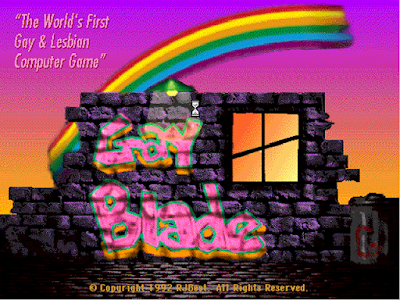 |
| There’s no way it’s the world’s first. What about Leather Goddesses of Phobos? What about the game version of The Rocky Horror Picture Show? |
GayBlade is a gay-themed game if by “gay-themed” you mean taking all the trappings of a typical computer role-playing game and replacing them with trappings of gay life. Not real gay life, but stereotypically flamboyant gay life, and not “replaced” in any thoughtful way but clumsily and senselessly. Let’s start with the classes. In place of fighters, samurais, wizards, and priests, we get queers, drag queens, guppies, and lesbians. Mages and masters aren’t even translated. Prime requisites are lowered significantly, and instead of default-naming every character “Dufus,” this game picks names that begin with the character’s class. You can only create four characters instead of being able to create up to 8 and only assign 4 to the party the way the other games work.
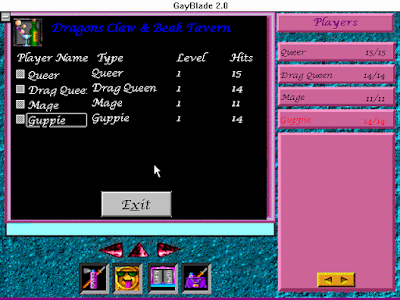 |
| Assembling a gay party. |
Then we get to inventory. Instead of useful items like armor and swords, we get aprons, mace (not the weapon, but the chemical spray), blow-dryers, press-on nails, and condoms. If the relative positions are any guide, purses are substituting for cloaks, tiaras for helms, press-on nails for gauntlets, and condoms for shields. Okay, I just got that last one. That’s a little clever.
The ostensible goal of the game is to rescue someone named “Empress Nelda.” But once you enter the dungeon, you’re just in the same medieval dungeon as the straight versions. Some of the monsters are replaced with menaces to gay people, such as “FBI Probes,” homosexual thugs who say “you fag” when they attack, televangelists, KKK grand dragons, and spineless politicos. You even have to face some external representations of inner demons such as suicidal tendencies and age spots. But there are also regular monsters carried over from DragonBlade, like giant insects and rats. The spells aren’t “translated” at all. Drag queens get the priest spells.
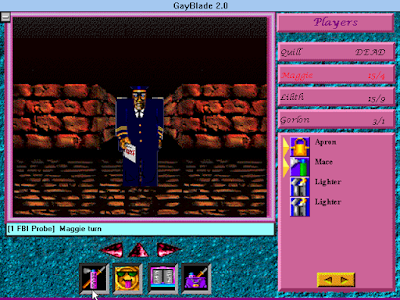 |
| The characters face an “FBI Probe” led for some reason but a naval officer. |
I tried to last long enough to explore the first level. I’m pretty sure it’s only 10 x 10. I didn’t find any special encounters or navigation tricks. But my queers and lesbians and their mace and hairdryers were far less effective against enemies than the swords and armor of the fantasy versions. I hate the control system in all three games: they’re mouse-buttons only, even for movement. I also hate the perspective, which insists you’ve hit a wall (not only subtracting a hit point but making you acknowledge a message) even though it looks like there’s plenty of space.
 |
| Sure, it was “plainly marked.” ONE SQUARE AHEAD of where I am. |
I’ll leave it to you, gay readers: what impressions do you get from this description? Are you happy to have any acknowledgement, even if the best it aspires to is high camp and doesn’t really succeed even at that? This will be better served in a longer entry specifically on the topic, but milestones that I can remember for gay representation in RPGs are:
- Ultima VI (1990): Earliest game that I can remember that allows same-sex sex, albeit with a gypsy prostitute.
- Ultima VII (1992): Continues the tradition, albeit at a brothel.
- The Elder Scrolls III: Morrowind (2002): Made things equal-opportunity for creepy sex predators, as Crassius Curio will sexually harass males and females alike.
- Jade Empire (2005): Introduced BioWare’s from-then common theme of offering at least one same-sex partner, often a bisexual who could also be romanced from the other side. I remember accidentally falling into a gay relationship based on some tricky dialogue options.
- Fallout: New Vegas (2010): In a game famous for not introducing “romance options” with its NPCs, the only exception (sort-of) is for lesbian characters.
- The Elder Scrolls V: Skyrim (2011): Introduced full equality. Any character who could be romanced, married, and bedded could be done by both men and women with no additional commentary. Unfortunately, all relationships were a bit boring and bloodless.
- Dragon Age: Inquisition (2015): Kicks up the complexity a notch with a wide cast of characters with a variety of racial and sexual preferences–plus mature attitudes (and a sense of humor) about sex and sexual situations.
I’m sure more experienced readers can think of more, but for 1993, I think you’d be better off playing a regular CRPG and just imagining the protagonist as gay rather than paying homage to this penis-lollipop take on gay themes. Even if you feel differently, I simply can’t bring myself to fight rednecks with press-on nails and blow-dryers for 13 levels.
Thus, I guess I’m rejecting the entire group on “notability” grounds, although I’ll hold myself open for taking up one of the medieval versions if I can get Basilisk to slow it down. I’m done with it for now; the game has kept me too long from Ultima VII.
Note: The title of the gay version is perhaps a reference to Zorro: The Gay Blade (1981), which not enough people have seen. Ironically, the authors removed swords and daggers from the game so that the characters no longer have any blades.
*****
I’ve put Planet’s Edge on the back burner because it’s clear that I’m going to have to start over. I’ll pick it up again after a couple of games have gone by; this isn’t going to be another Magic Candle III. I just hate doing the same things I’ve already done, and I needed some space in between.
Original URL: http://crpgaddict.blogspot.com/2020/04/what-i-can-tell-you-about-dragonblade.html

